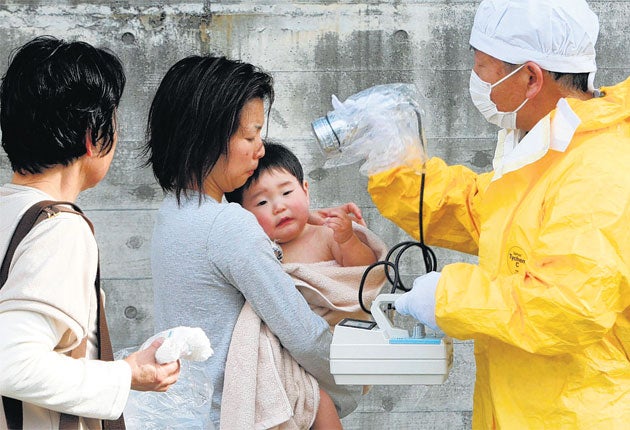Radiation leak is 'substantial' and risk of pneumonia still high

The radioactive cloud of steam and gases blown into the air by the explosions at the reactors in the Fukushima nuclear plant are unlikely to pose a major health risk, radiation experts said yesterday – although any future explosion could change the situation.
Relief agencies said the main threat for those who had survived near- drowning in the tsunami would be pneumonia, caused by fluid retained in the lung.
Thousands of corpses litter coastal towns but outbreaks of diseases such as cholera are considered a low risk in a developed country.
The Kyodo news agency reported that although radiation levels fell on Sunday after Saturday's first explosion, they rose above the benchmark level of 500 microsieverts per hour at two locations yesterday, more than half the annual 1,000 microsieverts to which people are normally exposed in a year.
One nuclear plant worker was reported to have been taken to hospital with radiation exposure and two others fell ill in the control room.
Professor Malcolm Sperrin, director of medical physics and clinical engineering at Royal Berkshire Hospital, said the readings indicated a "substantial release of radiation", but they were likely to have been taken at points close to where it was being emitted.
The Fukushima disaster was "totally different" from Chernobyl, where there was a fire in the reactor core sending a plume of radioactive material into the sky and exposing hundreds of thousands of people to radiation. At Fukushima, it was vaporised coolant – radioactive steam – that was released into the atmosphere, not material from the reactor core.
"There has been a minor increase in radiation. It is measurable but whether that increases individuals' risk is another matter. I would be surprised if there is a significant radiation leakage now," Professor Sperrin said.
Around 185,000 people have been evacuated from the 12-mile exclusion zone around the reactors, according to the International Atomic Energy Authority. Japanese officials said the amount of radiation released was too low to cause harm, but as a precaution they widened the evacuation zone, warned people to stay indoors and have distributed 230,000 iodine tablets to evacuation centres.
These can prevent thyroid cancer caused by the release of radioactive iodine, one of the immediately harmful products of a radiation leak. Radioactive iodine tends to accumulate in the thyroid gland but by taking tablets the body's need for iodine is met and it stops absorbing the radioactive version.
Other materials such as radioactive caesium are absorbed by all parts of the body and have more dissipated effects.
The radioactivity does not last – in the case of radioactive iodine it is mostly gone within a month and, for caesium, within a year.
There is no safe level of radiation – any dose is deemed to increase cancer risk. However, everyone is exposed to background radiation – in the rocks in the ground, as passengers during international flights, and during medical procedures such as X-rays.
Subscribe to Independent Premium to bookmark this article
Want to bookmark your favourite articles and stories to read or reference later? Start your Independent Premium subscription today.

Join our commenting forum
Join thought-provoking conversations, follow other Independent readers and see their replies